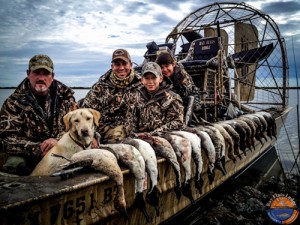October 2013
Things haven’t really cooled-off around here like we’re used to seeing by now. This being the case, and since we should probably start seeing higher tides this month, we will soon start searching for trout and red fish in some of the more popular back lakes that line the inland-side shoreline of Matagorda Island just adjacent to San Antonio Bay and Espiritu Santo Bay. Historically, the back lakes become very good producers beginning in October, and some of our late September catches have supported that statement. When the guides hunt for fish in these secluded areas at this time of the year, they have a list of things they like to see before spending the time of stopping the boat, anchoring, and then wading blindly across a muddy shoreline. The first thing we like finding is nervous mullet. This can mean schools of mullet on top of the water, groups of mullet swimming just beneath the surface, or individual mullet that appear to be playing hopscotch as they are chased from one place to another. Another thing we have found to be a good indicator of fish is the presence of birds, particularly pelicans. Regardless of whether the pelicans are diving or just sitting on top of the water, our odds are much better when they are there.
Some of the best lake spots this fall will be areas where there’s soft sand mixed with vegetation. The really muddy spots will turn on strong once the air and water temperatures drop significantly later in the year, but until then we will look for sand and grass. The grass will be holding mullet, and that’s where the trout and reds will be found, also. If we’re way back inside a lake on a really windy day, the first place we like searching for the mullet is where the wind is blowing the water directly against the shallow shoreline. This generally is where we’ve found red fish populations hanging out snacking on the mullet being blown into the shore. In some instances, the water in these conditions can become very murky, but don’t let that bother you. You can often learn quite quickly that the muddiest water really doesn’t bother the reds. The guides made many casts with a bone-colored top water across some of the dirtiest water imaginable only to be pleasantly surprised by the outcome afterwards, especially when working the lure right along the line where the color of the water changes from dirty to green, or clear.
When we look for trout in these secluded lake areas, we still look for them over the sand and the grass, but not in the muddied water. We found that the trout prefer our artificial baits better when they can clearly see them, and that means we’re looking for some of the clear and descent water that’s readily available above the grass in the back lakes. Your will find us starting out very early in the morning throwing a surface walker like that of the smaller-size Super Spook or Skitter Walk. If the sun is shining we like the Clown color, and the Baby Trout color on cloudy or overcast days. As the day gets lighter and the temperature rises a bit, then we like to transition to plastic baits and begin working the baits in a little bit deeper water further away from the grassy shore itself. A personal favorite of our guides is to work in soft sand and grass about fifty yards off the bank along a tapered shoreline. We’ll sit there and attempt to get our lure closer to the grass along the bank on each cast. We like counting the number of casts before having that first strike telegraphed back to us via the line and the rod. Sometimes we don’t have to count very long at all before we experience a tug that messes-up our counting altogether!
As we get further into October, the total amount of daytime hours will continue to decrease, meaning less total sunlight each day. This is when we begin throwing darker baits. Darker colors tend to reflect a silhouette much better in the low-light conditions that are more typical this time in the year. Bay Flats Lodge would like to give Captain Doug Russell a warm welcome as our latest guide working with the lodge. Until next time, be courteous while on the water, and remind yourself to always approach wade fishermen while idling slowly, or pass them with good distance.
Remember to practice CPR, “Catch, Photo, and Release”, whenever possible on trophy Trout and Reds…Guide Chris Martin, Port O’Connor/Seadrift region. www.BayFlatsLodge.com…1-888-677-4868.

Waterfowl hunting on the Texas middle coast near Port O’Connor has been a favorite pastime for many years. Last season photo by Capt. Chris Martin
